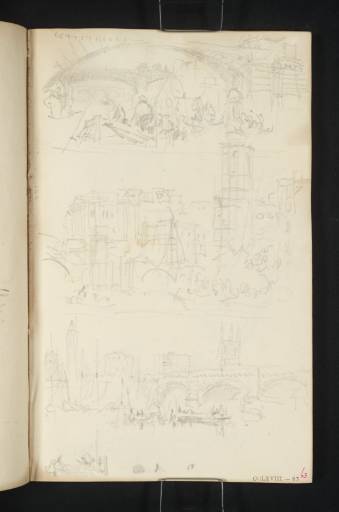These three sketches that Finberg identified as London Bridge do not seem to relate to anything else in the sketchbook, apart, perhaps, from the sketch of figures in a barge on folio 68 verso (
D26225) which may have been made at the same time. The three sketches are quite highly worked considering their scale. This may suggest that Turner was keen to see the three compositions side-by-side; an approach he also adopted for the vignette studies on folios 28 verso and 29 (
D26149,
D26150).
At the top of the page is a sketch of three of four crowded boats beneath one of the arches of London Bridge that was probably made from the water. The view is looking west and through the arch can be seen two other bridges: John Rennie’s 1819 Queen Street Bridge (popularly known as Iron Bridge, the precursor to Southwark Bridge), and the previous Blackfriars Bridge (originally called William Pitt Bridge).
The middle sketch was also made from the water and depicts the northern-most arches of London Bridge, with the tower of the church of St Magnus the Martyr to the right and the classical portico of Fishmongers’ Hall (1833) to the left. Turner has suggested the carved coat of arms of the Worshipful Company of Fishmongers at the top of the eastern façade of the building with some scribbled shapes. Further scribbles by the water indicate figures in boats.
The bottom sketch looks south-west to the Southwark end of London Bridge. To the left is the shot tower and to the right is the tower of St Saviour and St Mary Overie (now Southwark Cathedral). In this sketch Turner is again interested in the activity of boats on the Thames. There is a further sketch of a boat and figures at the bottom left of the page.
London Bridge was of recurring interest to Turner, who sketched the structure and the city nearby at various points throughout his career.
Thomas Ardill
January 2011

